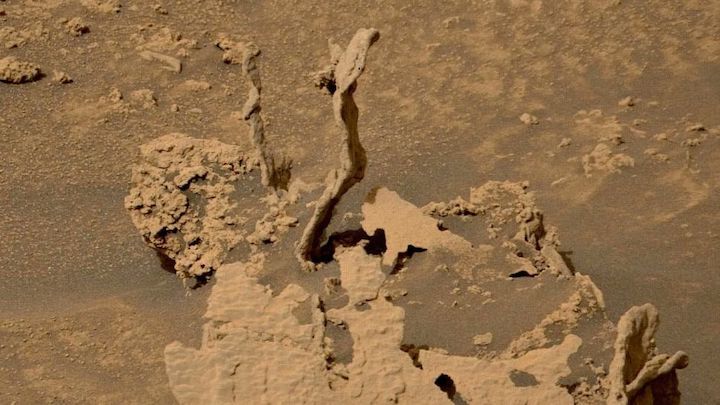6.06.2022
The weird features point to a complex history of geology on the Red Planet.

'Spikes' spotted by the Curiosity rover on May 17, 2022. (Image credit: NASA/JPL-Caltech/MSSS)
A long-running NASA rover imaged twisted Red Planet rock pillars.
The Curiosity rover spotted(opens in new tab) the sinewy rocks on May 15, according to raw images the mission sends down to Earth. The images were obtained on Sol (Martian day) 3474 of the mission, as Curiosity speeds towards completing its first decade of work on Mars on Aug. 6.
"The spikes are most likely the cemented fillings of ancient fractures in a sedimentary rock," the SETI Institute wrote(opens in new tab) of the feature on May 26. Sedimentary rock is formed by layers of sand and water, but the rest of the rock feature "was made of softer material and was eroded away," the institute added on Twitter.
The delicate features may also have been shaped by the planet's lighter gravity, which is about one-third of what we experience on Earth. SETI, however, did not elaborate on other environmental factors in its tweet. The size of the features was also not specified.
On sols 3473 and 3475, Curiosity was working at a location on Mount Sharp (Aeolis Mons) nicknamed Mirador Butte, according to a statement posted to the mission's official blog(opens in new tab) at NASA's Jet Propulsion Laboratory on May 13.
Curiosity's Mast Camera or Mastcam, which took the odd Mars rock picture sometime during this period, was going to be "very busy in this interesting landscape," according to Curiosity blog post writer Susanne Schwenzer, a planetary geologist at The Open University in the United Kingdom.
"There will be a mosaic on the hill just off at a distance, now called 'Sierra Maigualida,' which will tell us more about the textures of the uppermost unit of the hill," Schwenzer said of the imaging plan.
The rover was also expected to examine "interesting structures" on a target nicknamed "La Paragua," to do multispectral analysis on a second target called "San Pedro," and to use stereo imaging on a feature called Tapir, which was likely formed by sediments forming rock via chemical and physical changes.
Curiosity is on a long-term plan to seek habitable conditions at Gale Crater, and is now climbing Mount Sharp to look at environmental depositions over the eons.
A newer NASA rover, Perseverance, landed Feb. 18, 2021, to seek potential ancient microbes in an ancient river delta inside Jezero Crater. Perseverance plans to cache some samples for a future mission to pick up for shipment to Earth in the 2030s.
Quelle: SC
